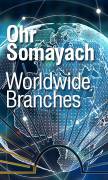Naso: Coincidence or Happenstance? (Part 2/2)
In Part I of this essay, we explored the Hebrew term mikreh/keri — a concept tied to an “occurrence” resulting from randomness and flippancy. In doing so, we examined its linguistic roots, tracing its evolution from denoting unexpected occurrences to its later rabbinic usage concerning ritual impurity. Rabbi Shlomo Pappenheim’s analysis framed keri within the broader context of the biliteral root KUF-REISH, linking it to impactful encounters. We also examined parallels with mikreh (chance events) and Malbim’s distinction between mikreh and metziah. In the upcoming installment, we will delve deeper into the synonyms te’unah and i’rua, investigating their nuanced relationships with keri and their possible implications for understanding Divine providence versus human perceptions of randomness.
In Modern Hebrew, the standard term for a “car accident” or “car crash” is a te’unat derachim (literally, “occurrence of the roads”). The first word of that phrase uses te’unah in the construct form. That terminology ultimately derives from the Biblical Hebrew root ALEPH-NUN-HEY which refers to something “happening.” For example, one Biblical verse says "No evil shall befall [lo te'uneh] you" (Ps. 91:10) and another verse says "any misfortune will not befall [lo ye'uneh] the righteous” (Prov. 12:21). Likewise, in the case of the inadvertent killer, the Torah says that Hashem will make his comeuppance “occur” for him (inah l’yado) in that he will be sent to exile as an atonement for his actions (Ex. 21:13).
In that last case, Rashi explains that Hashem will arrange for said killer to somehow end up being held accountable by being put in a position where it will be clear that he is an inadvertent killer that must flee to a City of Refuge. By way of illustration, Rashi explains that Hashem will arrange that a murderer (who should be liable for death penalty) and an inadvertent killer (who should be liable for exile to a City of Refuge) will end up getting their due through Divine intervention. Hashem will set things up so that the two men will “meet” and the inadvertent killer will inadvertently kill the murderer in front of witnesses. When that happens, the murderer will receive his punishment (he gets killed) and the inadvertent killer will receive his punishment (the witnesses will testify against him and lead him to be sentenced to a City of Refuge).
What is the difference between mikreh/keri and te’unah, if both words seemingly refer to the same sort of “happening/occurrence”? The Malbim (in Sefer HaCarmel) differentiates between these two apparent synonyms by explaining that mikreh refers in general to the meeting point between various things (perhaps a more physical “impact,” per Rabbi Pappenheim), while the term te'unah refers to the confluence of the incident’s causes (seemingly a more abstract coming together of various factors and triggers). To highlight this distinction, the Malbim notes that in the case of the inadvertent killer, Hashem does not directly bring the inadvertent killer to the City of Refuge (which would be a “physical” point of contact between the killer and a geographical location), rather He connects the inadvertent killer with the circumstances that will cause him to be sent to a City of Refuge (which is a more “abstract” way of causing the killer to meet his fate).
Another term that refers to an “occurrence” is i'rua (whose root is ALEPH-REISH-AYIN). In Modern Hebrew, it is used to refer to any sort of "event" (like a wedding, birthday party, or conference). This term does not appear in the Bible, but verbs forms already occur in the Mishnah. For example, the Mishnah famously states that five things “happened” on the 17th of Tammuz (Taanit 4:6). Likewise, when the Mishnah refers to somebody becoming disqualified from offering a Paschal Offering (Pesachim 8:6) or something happening that disqualifies a Red Heifer (Parah 4:4) or other sacrifice (Zevachim 12:4), the Mishnah uses the verb i’ra. The term i’ra also refers to something that could “happen” to a person that might keep him preoccupied, like a wedding or bereavement (Kilayim 7:7, Taharot 9:2, Moed Katan 2:1-2, see also Brachot 4:2). In many cases, the "happening" denoted by this verb is associated with keri in the rabbinic sense (Yoma 1:1, Avot 5:5, Tamid 1:1, Middot 1:9, 2:2). In general, the different forms of the Hebrew words mikreh/keri are usually rendered by Targum in Aramaic with cognates of the i'rua (spelled ALEPH-REISH-AYIN) or ara (spelled AYIN-REISH-AYIN). In one particular verse, "Lovingkindness and truth met [nifgashu], righteousness and peace kissed" (Ps. 85:11), Targum renders the word for “met” into Aramaic/Syriac with a cognate of i’rua.
Rabbi Shaul Goldman offers a fascinating insight into the shared etymological threads that run through the various Hebrew terms for “happenstance” discussed throughout this essay. He proposes that the very concept of an “event/occurrence” is often framed in spatial-metaphoric terms, as something that falls or lands — a linguistic motif that conveys the idea of an occurrence that emerges without an overt pattern or discernible intention. That is, when something happens, it is construed as having “landed” in a particular time and place, as though it were cast from above and struck the ground at random.
In other words, we have previously noted how the terms mikreh/keri and their cognates imply a convergence or collision of multiple, seemingly unrelated factors which give rise to a specific outcome (a “happening”). But Rabbi Goldman takes this further by noting that the impact of these converging forces is consistently conceived as a downward fall — perhaps because the most universal form of “impact” in the physical world is the result of gravity. Thus, the default linguistic metaphor for any sudden or unexplained “happening” is that of something falling and thereby landing.
This same idiom appears in English, where one speaks of a holiday or event “falling out” on a particular date (e.g., “Father’s Day always falls out on a Sunday” or “Pesach never falls out on a Monday”). Such phrases reinforce the impression that events fall into specific temporal coordinates without human orchestration. Similarly, when a random set of causes “lands” in one configuration rather than another, the result is an event that appears spontaneous or coincidental. As with a free-falling object, which must land somewhere, so too the combined variables culminate in a specific “happening,” (even if it is whether preordained by quantum mechanics, Fate, and/or Hashem’s Will).
This metaphor is also embedded in the etymology of several English words related to happenstance: incident, accident, and coincidence all derive from the Latin cadere meaning “falling upon.” The word befalling makes this connection explicit, and landing denotes the terminal locus of a fall as hitting the ground. Terms such as somewhere, wherever, and whenever connote an indiscriminate place or time that is not predetermined or deliberate, but simply happens as a coincidence, emphasizing the idea of a random occurrence emerging without any calculated planning.
With this philosophical framework in place, Rabbi Goldman demonstrates how the Hebrew terms we have explored likewise hearken back to this spatial-convergence model. As previously discussed, the root of mikreh/keri suggests an occurrence that results from the simultaneous convergence of multiple causes impacting each other. Via phonetic shifts and the interchangeability of certain letters (notably REISH and LAMMED, plus HEY and AYIN), the root KUF-REISH-(HEY) may also relate to KUF-LAMMED-AYIN (“to sling, hurl”), evoking the image of a projectile impacting a target — again reinforcing the theme of landing and collision. This association is further corroborated by the Talmudic Aramaic verb ikla, denoting someone who happens to arrive at a particular place, seemingly without forethought.
Moreover, these roots are also related to other words that center on the notion of “ground” or “impact surface.” The Hebrew word karka (KUF-REISH-KUF-REISH, a doubling of the KUF-REISH root) refers to “land” or “ground,” as does the Biblical Aramaic arka (“land”), which appears once in the Bible (Jer. 10:11).
Additionally, the standard Aramaic term for “land” is ar’a (ALEPH-REISH-AYIN), a cognate of the Hebrew eretz (with the Hebrew TZADI morphing into an Aramaic AYIN). The root of ar’a is the same as the root of i’ra/i’rua, ALEPH-REISH-AYIN. In this sense, i’rua denotes not only something that “happens,” but also conjures the image of something landing on the “ground.” Other usages of the root ALEPH-REISH-AYIN in Targumic Aramaic refer to “ruin” or “collapsing” (not unlike the English idiom of “running into the ground”).
Another term associated with KUF-REISH – kara/kriyah/vayikra — while primarily meaning “to call” or “to proclaim,” may also suggest a kind of deliberate “summoning” of an event. This actually leads to a paradoxical dual usage for both purposeful invocations (like mikra kodesh) and seemingly random occurrences. This allows those words to occupy a unique semantic middle ground between accident and intention. The Targumic rendering of this root as AYIN-REISH-AYIN also enters this discussion, especially because the interchangeability of AYIN and ALEPH connects AYIN-REISH-AYIN with ALEP-REISH-AYIN, again bringing us full circle. [Although the word ara’i is sometimes spelled ALEPH-REISH-AYIN, Rabbi Goldman maintains that the correct spelling is its usual spelling of AYIN-REISH-ALEPH. He understands that this term has nothing to do with i’rua and instead simply denotes non-permanence.]
Beside the root of te’unah referring to an “occurrence,” the root ALEPH-NUN-(HEY) also gives way to the interrogative word anah meaning “where?” (in reference to an unknown geographical location). Rabbi Shaul Goldman accounts for the connection between these two terms that derive from the same root by noting that this convergence underscores the notion that te’unah focuses not necessarily on the causes or effects of an event, but on the unpredictability of its location — the arbitrary “where” of its landing point.






